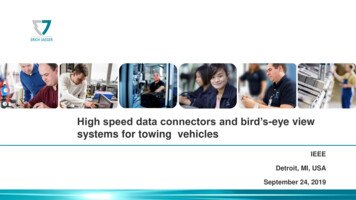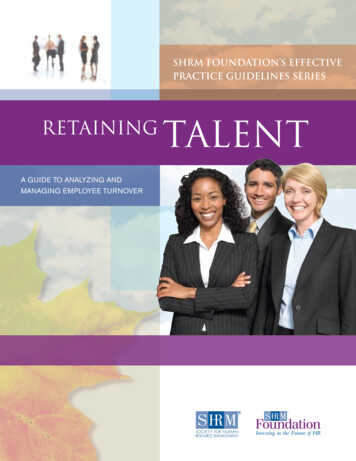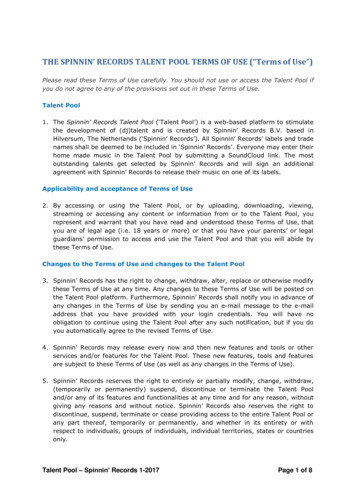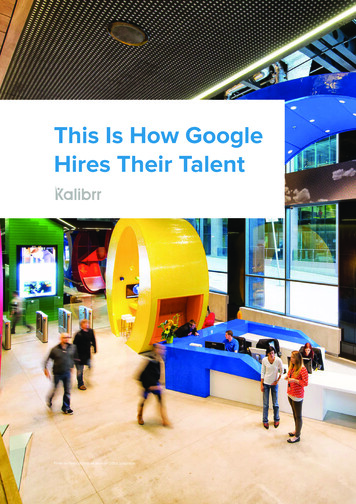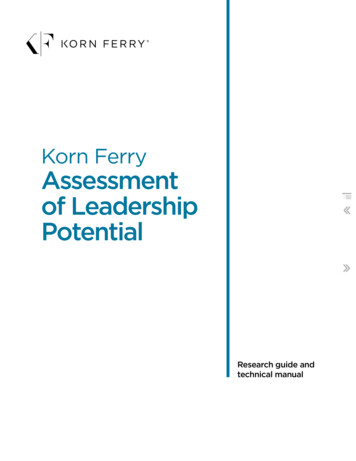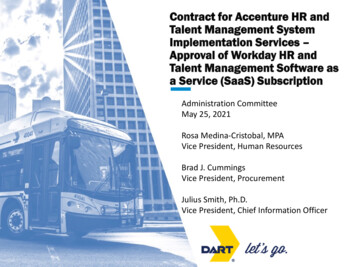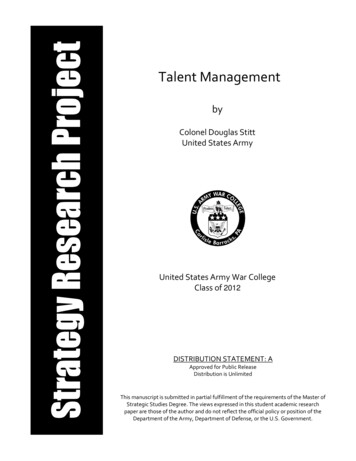
Transcription
WHITE PAPERHigh-potential TalentA View from Inside the Leadership PipelineBy: Michael Campbell and Roland Smith
ContentsExecutive Summary2Background4Who is a High potential?5An Organizational Perspective6An Individual Perspective9The Impact of High-potential Identification10Formal vs. Informal—Differences in Developmental Experiences11Formal vs. Informal—A Mixed Reaction12Engaging High potentials16Formal vs. Informal—Differences in Commitment and Engagement17Increasing High potential Commitment and Engagement18Shifting Roles: High potentials as Talent DevelopersFormal vs. Informal—Differences in Developing Others2021Leveraging the View from the Pipe—Recommendations and Next Steps22Conclusion26Resources27References27About the Authors and Contributors28About the Research291
Executive SummaryTalent management represents an organization’s efforts to attract, develop, andretain skilled and valuable employees. Itsgoal is to have people with the capabilities and commitment needed for currentand future organizational success. Anorganization’s talent pool, particularlyits managerial talent, is often referredto as the leadership pipeline.1The leadership pipeline is managedthrough various systems and processesto help the organization source, reward,evaluate, develop, and move employeesinto various functions and roles. Thepipeline bends, turns, and sometimesbreaks as organizations identify whois “ready now” and who is “on track”for larger leadership roles. From thisperspective, talent management is something done to and for an organization’shigh-potential employees, in service ofthe organization’s needs.2 2014 Center for Creative Leadership. All rights reserved.But talent management has another,overlooked perspective: The view fromthe pipe.The employees and managers who are inside the leadership pipeline do not operate solely as a stream of talent to be funneled and directed by the organization.They bring their perspectives and experiences to the process, too. CCL’s researchteam decided to factor in the views ofhigh-potential managers to deepen ourtalent management knowledge and thatof executives and talent professionals.
To examine talent management through the eyes of high-potential managers, wesurveyed 199 leaders attending CCL’s development programs. The findings haveimplications for how organizations identify, invest in, and leverage their highpotential talent. Major findings from this research include:Respondents say formal identificationas a high potential is important.Most survey respondents (77%) place a high degreeof importance on being formally identified as a highpotential in their organization. The study showed severalclear differences between high potentials who have beenformally named and those who are perceived to be highpotentials. Notably, only 14% of formally identified highpotentials are seeking other employment. That numbermore than doubles (33%) for employees who are informally identified as high potentials.High potentials expect more development, support, and investment—and they get it. High potentialsreceive more development opportunities—such as specialassignments and training as well as mentoring and coaching from senior leaders—than other employees. This is asit should be, according to the respondents: 84% of highpotentials agree that organizations should invest morein them and other valuable talent. The extra investmentis one reason why being formally recognized as a highpotential is considered important.High potentials are more committedand engaged when they have a clearcareer path.The most frequently mentioned way to increase commitment and engagement among all high potentials is tohelp them identify a career path. High potentials want tohave a picture of where they are going and to understandnext steps in terms of development, experience, andmovement. In addition, as high potentials receive greaterresponsibility, they are also looking for greater authorityto make decisions that have a significant impact on theorganization.High potentials help develop others.While high potentials are the recipients of increasedopportunities and investment, they are also talent developers in the organization. Many (84%) are activelyidentifying and developing potential in others. They haveinsight and experience that is needed for developing thenext layer of high potentials, as well as the larger talentpool.High potentials feel good about theirstatus—but it has its downside.Survey respondents generally expressed positive feelingsabout being identified as a high potential by their organization. At the same time, the designation isn’t exclusivelya win for those in the pipeline. For some, there is a feeling of increased pressure or anxiety around high expectations or performance; others experience frustrationaround the organization’s unclear intentions. 2014 Center for Creative Leadership. All rights reserved.3
BackgroundCCL’s leadership development programs are oftenattended by leaders who have been identified ashigh potentials within their organizations. Withaccess to a population of high-potential leaders from different organizations, we wanted toknow, what is the view from inside the leadership pipeline?Through our study, we sought to learn more abouthow organizations designate their high potentialsand what impact does that status have on the talent? How important is high-potential status? Whatdoes being labeled a high potential feel like? Howdoes it affect a leader’s behavior? How committed and engaged are high potentials? How do theyinfluence the development of others?By exploring these questions, wehoped to better understand highpotentials and use our insightsto help organizations addressconcerns, leverage strengths,and proactively meet the needsof top talent.4 2014 Center for Creative Leadership. All rights reserved.Exploring theView from the PipeWho is a High Potential?Understanding how high potentialsperceive the organization’s talent management efforts and how high potentialspersonally experience those efforts.The Impact of High PotentialIdentificationExploring the differences in perceptionsand beliefs of formally and informallyidentified high potentials.Engaging High PotentialsHow to increase commitment to the organization and engagement to the work.Shifting Roles—High Potentialsas Talent DevelopersMaximizing investments in talent throughhigh potentials and their ability to identifyand develop talent in others.
Who is a High Potential?Broadly speaking, high potentials are the pool of future organizational leaders.For our study, we defined high-potential talent as an employee who isassessed as having the ability, organizational commitment, and motivation to rise to and succeed in more senior positions in the organization.2Different organizations will have their own definitions of high-potential talent,but the essence remains the same. More important than the exact definitionof high-potential talent is understanding how talent experiences being a highpotential in their organization. 2014 Center for Creative Leadership. All rights reserved.5
An Organizational PerspectiveTo understand how organizations are seen from the view from the pipe,we asked the study participants:Does your organization have a formal processfor identifying high-potential employees?How are high potentials treated differentlythan other employees in your organization?Have you been formally identified as ahigh-potential employee?Identifying High PotentialsMany organizations put considerable effort into identifying high-potentialemployees. Sometimes the process is formal and transparent, with high potentials being officially named and notified. Over half of the participants inthis study (56%) indicated that their organization has a formal process foridentifying high-potential employees (see Figure 1).Even with 37% of organizations using an informal process of identifying highpotential talent, most people are aware of their status. In the CCL study, 91%of participants know if they are high potential or not.As would be expected from a group of participants attending a leadership development program, 84% of the participants have in some way been informedthat they are considered high potentials (see Figure 2).6 2014 Center for Creative Leadership. All rights reserved.
Does your organization have a formal processfor identifying high-potential employees?Figure 18%37%56%YesNoNot SureHave you been formally identified asa high-potential employee?Figure 29%Yes31%7%53%NoNot SureNot Formally (but I havebeen told I am considereda high potential) 2014 Center for Creative Leadership. All rights reserved.7
Different Treatment for High potentialsWhile it’s generally recognized that organizations differentially invest inhigh potentials using development opportunities,3 it is less understoodhow high potentials view these investments.The view from the pipe recognizes that organizations treat high potentialsdifferently in the following ways (see also Figure 3):Visibility & AccessHigh potentials are given more visibility to seniormanagers and the organization. That visibility translates into increased opportunities to be coached ormentored, as well as being recognized by others inthe organization. High potentials are also includedmore often in senior meetings and have their opinions sought after more frequently.Greater ResponsibilityWhen a high potential is provided a special assignment, it likely means their level of responsibility hasincreased. While it may seem that high potentialsare rewarded with more work, the assignments areoften viewed as opportunities not burdens.Special Assignments & TrainingSpecial assignments are described as high-profilework, participation on a task force team, as well asrole rotations. High potentials also receive differentiated training that often includes additional optionsfor “higher dollar” training.Give an example of how high potentials are treateddifferently than other employees in your organization.Figure 323%21%16%13%9%8%6%5%08Visibility & AccessSpecial AssignmentsTrainingGreater ResponsibilityPromotability & RewardsMore Opportunities in GeneralFreedom/FlexibilityMiscellaneous51015 2014 Center for Creative Leadership. All rights reserved.2025
An Individual PerspectiveWhen high potentials are identified in the organization, what happens?To understand how study participants view the investments their organizations make in them and theexpectations they experience as high potentials, we asked a number of questions, including:To what degree do you receive developmentand support from your organization?Should high potentials receive more investmentthan others in the organization?How important is it to you to be formally recognizedas a high potential?The Personal Experiences of High potentialsThe personal experience of high potentials bears out their impression of what is going on in theorganization. Most study participants (77%) said that they are provided greater developmentalopportunities than others in the organization. Specifically they said they were given:Access to, and mentoring from, more seniororganizational leaders (73%).Coaching support from their boss (72%).Special developmental assignments (71%).Study participants also believe that high potentials should receive more investment than otheremployees in the organization (84%). High potentials are telling their organizations that theywant—and deserve—greater opportunities and investment in their development.The Importance Placedon High-PotentialStatusFrom the individual’s perspective, high-potential recognitionmatters. Formal recognition asa high potential is important to77% of study participants (seeFigure 4). This high degreeof importance suggests thatthe degree of transparencyand formality an organizationuses in its high-potential identification process does havea significant impact on thetalent pool.Figure 4How important is it to you to be formallyrecognized as a high potential?35%30%25%20%15%77%10%5%0%Not at allimportantExtremelyimportant 2014 Center for Creative Leadership. All rights reserved.9
The Impact ofHigh-potential Identification*The degree of transparency and formality of notifying employees of their status as a high potentialimpacts how employees see themselves and howthey see the organization.Study participants who are formally identified(F1) are more likely to consider themselveshigh potentials than those who were informallyidentified (I1) (see Figure 5). Official recognition, it seems, fosters the leaders’ identity as aFigure 5To what extent do you consider yourselfa high potential in your organization?100%80%18%68%To a very great extentTo a great extentTo some extentTo a little extent34%20%0%10%54%60%40%high potential. Without that recognition, leadersmay doubt or second guess their skill level orimportance to the organization. This implies thatpositive feedback, a good track record, or informalacknowledgement of one’s value is not equivalentto official status as a high potential, as recognizedby the organization.14%Not at all2%Formally Identified HiPo Informally Identified HiPoThe difference in perception between F1 and I1 talent has implications for organizations expecting toretain a large percentage of their high potentials. If employees are not formally recognized by theorganization as a high potential, they may be less likely to see themselves as a future leader inthe organization. Informal recognition alone may not be enough to convince employees that theyare part of the organization’s long-term plans.*Any analysis that compares formal to informal only includes those survey participants who indicated they were either formally or informally identified has high potentials, n 161 high potential leaders.10 2014 Center for Creative Leadership. All rights reserved.
Formal vs. Informal—Differences inDevelopmental ExperiencesHigh potentials experience increased opportunities and expect differential investment in theirde
But talent management has another, overlooked perspective: The view from the pipe. The employees and managers who are in-side the leadership pipeline do not oper-ate solely as a stream of talent to be fun-neled and directed by the organization. They bring their perspectives and experi-ences to the process, too. CCL’s research team decided to factor in the views of high-potential managers to .

